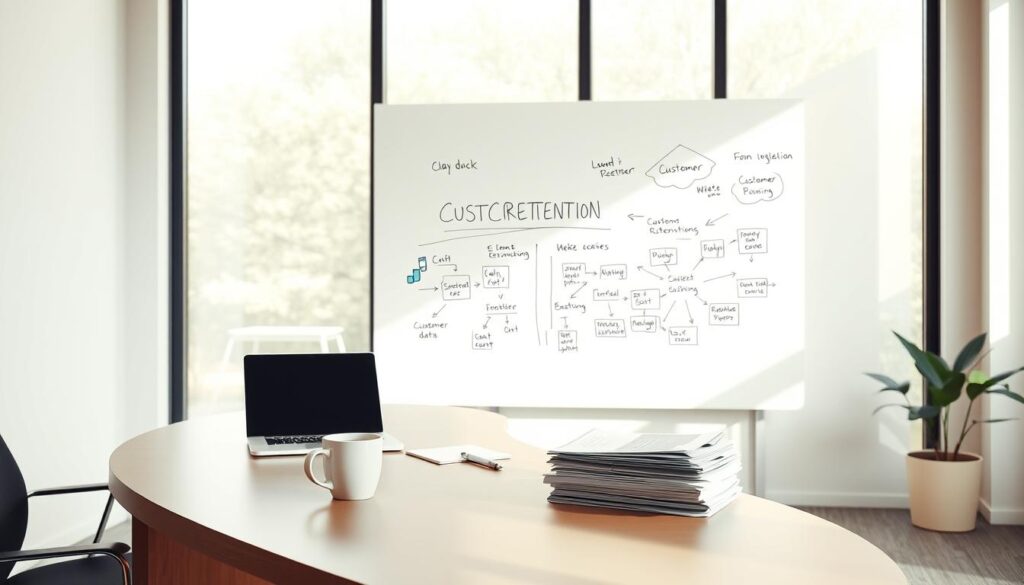In today’s competitive market, keeping customers is more crucial than ever. This clay.com customer retention strategies guide will explore key methods to boost customer experience and help your brand last. Keeping customers makes your brand more profitable and loyal.
By using the strategies in this guide, businesses can better satisfy their customers. They can also build lasting connections with them.
Key Takeaways
- Customer retention is crucial for sustainable business growth.
- Implementing effective strategies leads to enhanced customer satisfaction.
- Loyal customers contribute to increased profitability.
- Understanding customer behavior is key in refining retention tactics.
- Personalized communication fosters stronger relationships.
Understanding Customer Retention and Its Importance
Customer retention is key to a business’s strategy. Keeping current customers helps companies be more profitable. It saves money on finding new customers and builds stronger customer bonds, raising customer lifetime value.
Definition of Customer Retention
Customer retention means keeping customers for a long time. Companies work on making customers buy again and engage more. This is very important for success in a tough market, where keeping customers is cheaper than finding new ones.
Benefits for Businesses
There are many benefits to focusing on customer retention, such as:
- Increased Customer Lifetime Value: Loyal customers spend more often.
- Enhanced Brand Loyalty: Valued customers are less likely to leave.
- Reduced Marketing Costs: It’s cheaper to keep customers than to find new ones.
Investing in good customer loyalty programs can make customer relationships and business stronger.
Key Metrics to Measure Retention
It’s important to measure customer retention to see how engaged customers are and where to improve. Key metrics include:
| Metric | Description |
|---|---|
| Churn Rate | The percentage of customers who stop buying over a certain period. |
| Repeat Purchase Rate | How many customers buy more than once. |
| Customer Satisfaction Scores | How happy customers are with products or services. |
Using these metrics helps businesses get better at keeping customers, by always focusing on what customers need. Knowing this data shows which customer retention best practices work best and helps plan for the future.
Analyzing Customer Feedback and Behavior
Knowing what customers think and do is key for businesses to keep them coming back. By using smart ways to engage with customers, companies can learn what their customers really want and need. Getting feedback in various ways can make ideas for keeping customers better, leading to happier customers.
Gathering Customer Insights
When businesses listen to what their customers say, they can understand their experiences and what they expect. Methods like focus groups or interviews help get deep insights. Surveys are also great because they give clear feedback.
Using tools to measure things like how likely someone is to recommend the business can show customer loyalty. This helps businesses know if their customers are happy.
Utilizing Surveys and Reviews
Surveys and online reviews are very useful for seeing what customers think. These can show where a business might not be doing well in what it offers or how it serves. Encouraging customers to share their opinions can help businesses do better according to what makes customers happy.
Keeping an eye on reviews online can also help improve things and build trust among customers.
Understanding Purchase Patterns
Looking at how and when people buy things can tell businesses a lot. Knowing when people are more likely to buy can help make marketing better. Also, analyzing different groups of customers over time can give clear insights.
This helps in making the shopping experience more personal and fitting. For more info, check out resources on customer data analysis.
Building Relationships Through Personalization
Personalization is key to building strong customer relationships. By catering to individual preferences, businesses can boost brand loyalty. This approach enhances the shopping experience, leading to more customer retention and satisfaction.
Tailoring Communication
By studying customer data, companies can customize their messages. This makes connections stronger and boosts engagement. Businesses show they understand their customers, increasing loyalty.
Personalized Product Recommendations
Recommending products based on customers’ past behavior is crucial. It helps suggest items that match their interests. This method makes shopping easier and boosts sales by helping customers find what they love.
Engaging Through Segmented Marketing
Segmentation lets marketers craft targeted campaigns for different groups. Customizing messages for channels like email or social media increases engagement. This approach makes marketing relevant and improves the customer experience.
| Strategy | Description | Benefits |
|---|---|---|
| Personalized Emails | Customizing email content based on customer behavior. | Higher open and click-through rates. |
| Dynamic Website Content | Showing unique products based on user sessions. | Increased conversion rates and customer satisfaction. |
| Recommendation Engines | Using algorithms to suggest products to customers. | Improved relevance in suggestions leading to increased sales. |
Strategic Loyalty Programs That Work
Effective customer loyalty programs are a key way to keep customers coming back. There are many types of programs to choose from, fitting various business needs. This text will cover loyalty program types, how to put them into practice, and how to see if they’re working.
Types of Loyalty Programs
There are many customer loyalty programs out there. Each one aims to match different customer likes and shopping habits. Some well-liked options are:
- Points-Based Systems: Customers collect points for buying things. They can swap points for discounts or gifts.
- Tiered Loyalty: The more customers spend, the better the rewards they get. This encourages them to buy more.
- Subscription Models: Customers pay a fee to get special perks or discounts. This helps bring in a steady income each month.
Best Practices for Implementation
To make a loyalty program work well, follow these steps:
- Be clear about the program’s benefits. This draws people in.
- Make joining easy. This encourages more sign-ups.
- Keep in touch with customers. Make sure they know how to earn and use rewards.
Measuring the Success of Loyalty Programs
It’s vital to check how well your loyalty program is doing. Look at these details:
- Engagement rates show how much customers are using the program.
- Redemption metrics reveal how often rewards are being used.
- Customer feedback helps improve the program over time.
Offering Exceptional Customer Support
Great customer support is key to keeping customers happy. By focusing on this, businesses gain loyalty and better experiences. Using smart strategies for customer satisfaction leads to keeping more customers. Speeding up support processes lets customers get help faster.
Strategies for Improved Support
Offering multiple ways for customers to get in touch helps a lot. This lets them use their favorite ways to communicate, making their experience better. Being proactive, like sending follow-up messages, also boosts satisfaction and loyalty.
Utilizing Chatbots and AI
Chatbots and AI speed up getting help, providing quick answers. They take care of simple questions, so humans can handle the harder ones. This makes things more efficient and shows customers they’re valued all the time.
Creating a Knowledge Base
A good knowledge base lets customers help themselves, which they really like. It’s great for those who want fast answers without waiting. Keeping the knowledge base fresh with common questions shows commitment to great service.
Leveraging Technology for Retention
In today’s business world, using technology is key to keeping customers coming back. The right CRM tools help understand and track what customers like and do. This makes it easy to talk to customers in a personal way. Retention software helps with keeping up with customers and checking how well keeping them is going. It makes it easier to change plans when necessary. By looking at data, businesses can see trends and insights. This helps them make their customer keeping plans better.
Using Customer Relationship Management (CRM) Tools
CRM tools are important for keeping good relationships with customers. They let businesses see everything about how they interact with customers. This understanding leads to actions that fit each customer better. By keeping detailed records, businesses can quickly deal with customer issues and make them feel valued.
Implementing Retention Software
Retention software makes keeping in touch with customers easy through automated messages. It also checks how well businesses keep their customers. This helps see which ways of keeping customers work best. Then, businesses can tweak their methods to keep customers happier and more loyal.
Analyzing Data for Better Strategies
Looking closely at data helps make better plans for keeping customers. Businesses can see what customers like and how they behave. This helps figure out what works best for them. Using this information means making choices based on facts. This makes sure that plans for keeping customers get better as needs and markets change.

Creating Engaging Content to Stay Connected
Engaging content is key to keeping strong ties with customers. By making different kinds of content, businesses stay relevant and improve customer bonds. This strategy involves blogs, infographics, and videos. They should all engage the watchers, helping them feel connected to the brand.
Types of Content to Produce
It’s important to offer various content types to meet customer preferences. Think about creating:
- Informative blogs that solve common questions and offer new knowledge.
- Visual infographics that make complex info easy to grasp.
- Engaging videos for storytelling or sharing customer experiences.
Utilizing Social Media
Social media is great for engaging with customers. Posting often, interacting, and quickly replying can strengthen relationships and start conversations. Using social media helps make a brand more noticeable and keeps it in people’s minds.
Email Marketing Strategies
Email marketing is crucial for remaining remembered by customers. Sending personalized emails with special offers or content appeals to what they like. Good subject lines and interesting emails make campaigns more effective. This approach increases customer loyalty.
Rewarding Customer Engagement
Companies today see the big value in rewarding customer engagement. They use rewards to build loyalty and get customers involved with their brand. Rewards like referral bonuses and special deals keep customers happy and coming back.
Incentives for Referrals
Referral programs can help get more customers. When you reward your customers for bringing in new people, your brand grows. This can be done through discounts, gift cards, or special event invites.
Feedback Rewards Systems
Feedback rewards encourage customers to share their thoughts. They might get points or other rewards for filling out surveys or giving reviews. This helps collect useful feedback and builds a community. Customers feel valued and stay engaged with your brand.
Special Promotions for Loyal Customers
Special deals for loyal customers really improve their experience. Offers like exclusive discounts or early access to products show them you care. These rewards keep your customers loyal, ensuring your business’s success and strong relationships.
Tracking and Measuring Customer Retention Strategies
Effective tracking and measuring of customer retention strategies are key for any business’s success. By keeping an eye on important metrics, companies can understand what customers like and need. This section talks about the major performance indicators, the best tools for measurement, and why it’s important to look at trends over time.
Key Performance Indicators (KPIs)
KPIs are critical to check how well you’re keeping customers. By watching metrics such as:
- Customer churn rate
- Retention rate
- Customer lifetime value
you can really understand if your strategies are working. Paying attention to these metrics helps businesses change and improve their plans.
Tools for Measurement
Choosing the right tools to measure metrics makes a big difference. Some popular tools are:
| Tool | Purpose | Key Features |
|---|---|---|
| Google Analytics | Website Traffic Analysis | Real-time data, user segmentation |
| Mixpanel | Behavior Tracking | Event tracking, user funnels |
| HubSpot | CRM and Marketing | Dashboard insights, reporting |
These tools help businesses see their performance data clearly. This allows them to make smart decisions.
Analyzing Trends Over Time
Looking at trends over time is very valuable. It helps businesses know if they’re doing better with keeping customers. Spotting trends in how people respond and what they need makes businesses more adaptable. By updating strategies based on these trends, companies can keep their customers happier and more loyal.
![]()
Adapting and Evolving Retention Strategies
In today’s fast-paced market, companies need to keep updating their ways to keep customers. It’s important to always talk and listen to what shoppers want. By getting feedback from surveys or direct talks, firms can learn and improve.
Seeing what competitors are doing is also key. Learning from the wins and losses of others helps us see trends. It shows us where we might be lacking and gets us new ideas.
It’s vital to always be trying to do better. This means not waiting for problems to arise before acting. Checking how well things are going and always looking for chances to get better help a business grow. This way, a firm stays relevant to its customers and ahead in its field.
FAQ
What is customer retention and why is it important?
Customer retention is about keeping customers over time. It matters because it’s cheaper to keep current customers than to find new ones. It also increases how much customers spend and their loyalty to the brand.
How can businesses measure customer retention?
To measure customer retention, businesses look at churn rate, repeat purchase rate, and customer satisfaction scores. These numbers help understand how well the company keeps its customers and shows where to improve.
What strategies can businesses use to improve customer satisfaction?
To up customer satisfaction, companies can ask for feedback through surveys. They can talk to customers in a personal way. And they can start loyalty programs that give customers reasons to buy again.
Why is personalization crucial for customer retention?
Personalization matters because it makes offers and messages fit what each customer likes. This makes customers more loyal and increases their chances of buying again.
What types of loyalty programs effective for retaining customers?
Good loyalty programs include point systems, different levels of loyalty benefits, and subscriptions. These methods make customers want to keep buying by rewarding them.
How does exceptional customer support impact retention?
Great customer support helps keep customers by making their experiences better. It uses quick and caring responses, and proactive help. This leads to happier, more loyal customers.
What role does technology play in customer retention strategies?
Tech, like CRM systems and retention software, helps track what customers do and like. This lets businesses tailor their approach to each customer, making their strategies more effective.
What types of content should businesses create to engage customers?
Companies should make blogs, infographics, and videos that are interesting and useful. They should also use social media and emails to keep talking to customers, keeping them engaged.
How can customer engagement be increased through rewards?
Boosting customer engagement can be done with rewards for sharing, giving feedback, and special deals for loyal customers. This helps bring more business and strengthens customer relationships.
What metrics should businesses monitor to assess retention strategy success?
To see if retention strategies work, businesses should watch churn rate, retention rate, and customer lifetime value. Analyzing these KPIs helps refine strategies to be more effective over time.
How can companies adapt their retention strategies?
Companies can update their retention strategies by always getting customer feedback. They can also compare themselves to others and make ongoing improvements. This helps meet the ever-changing needs and wants of customers.



